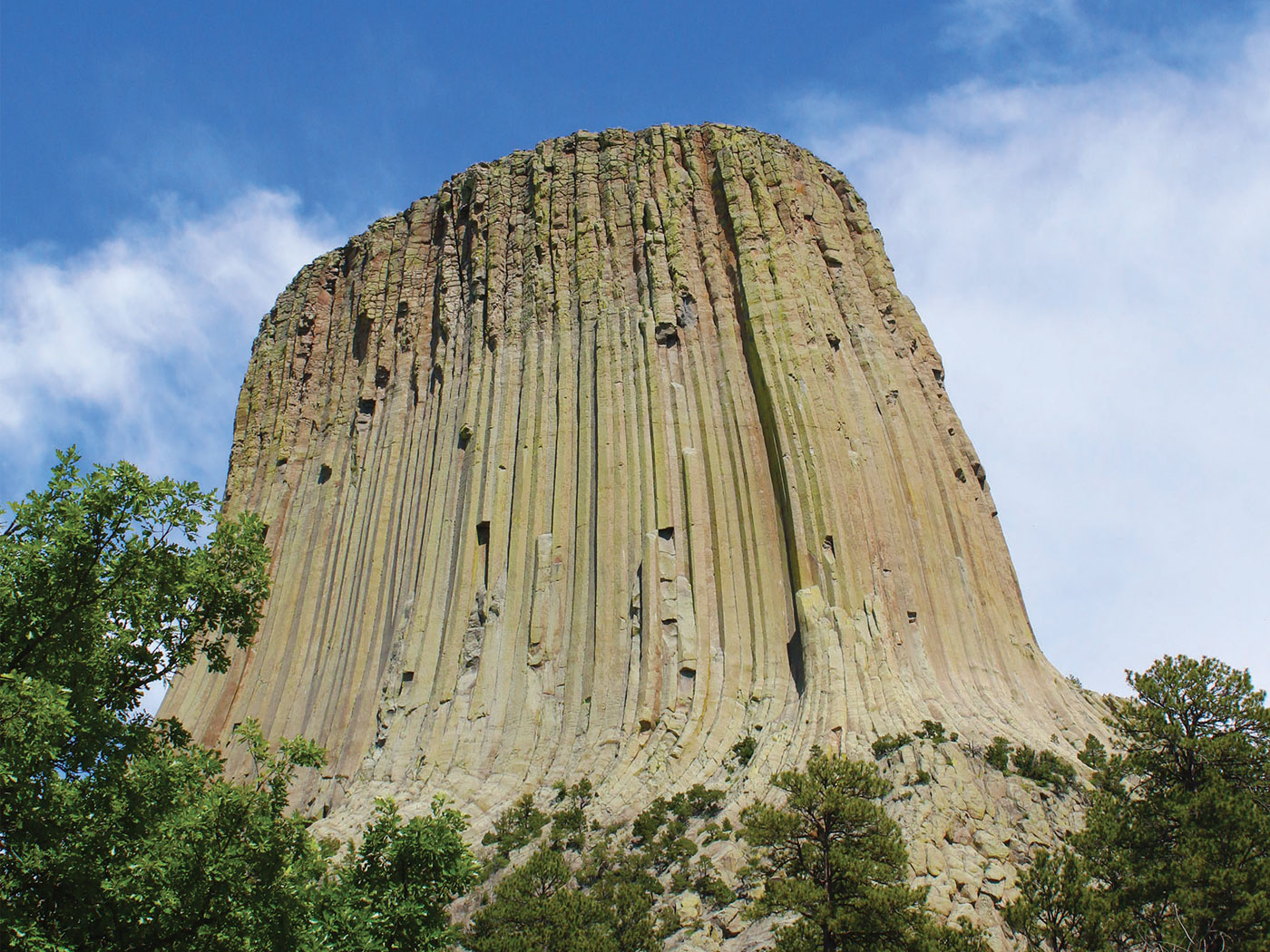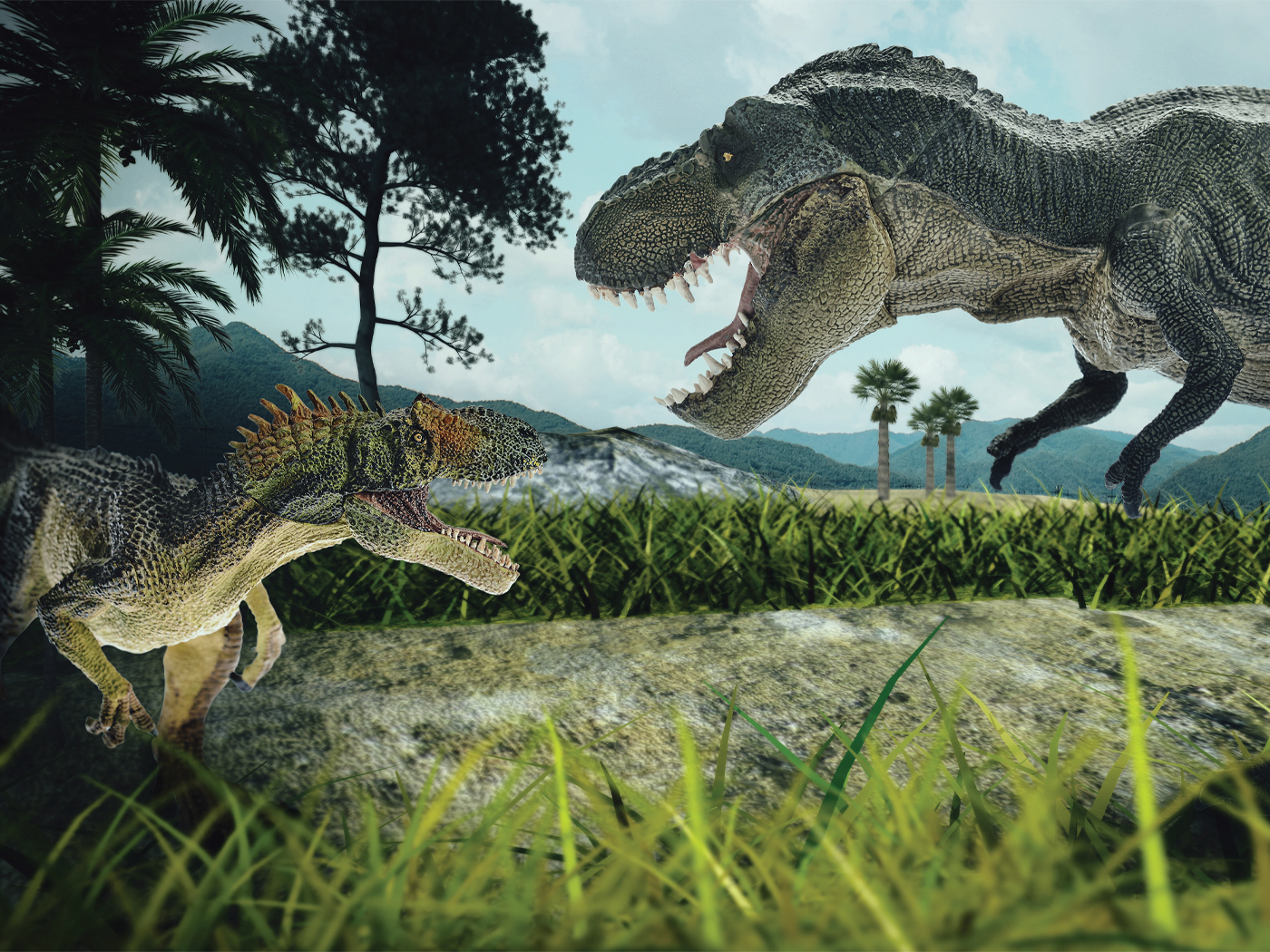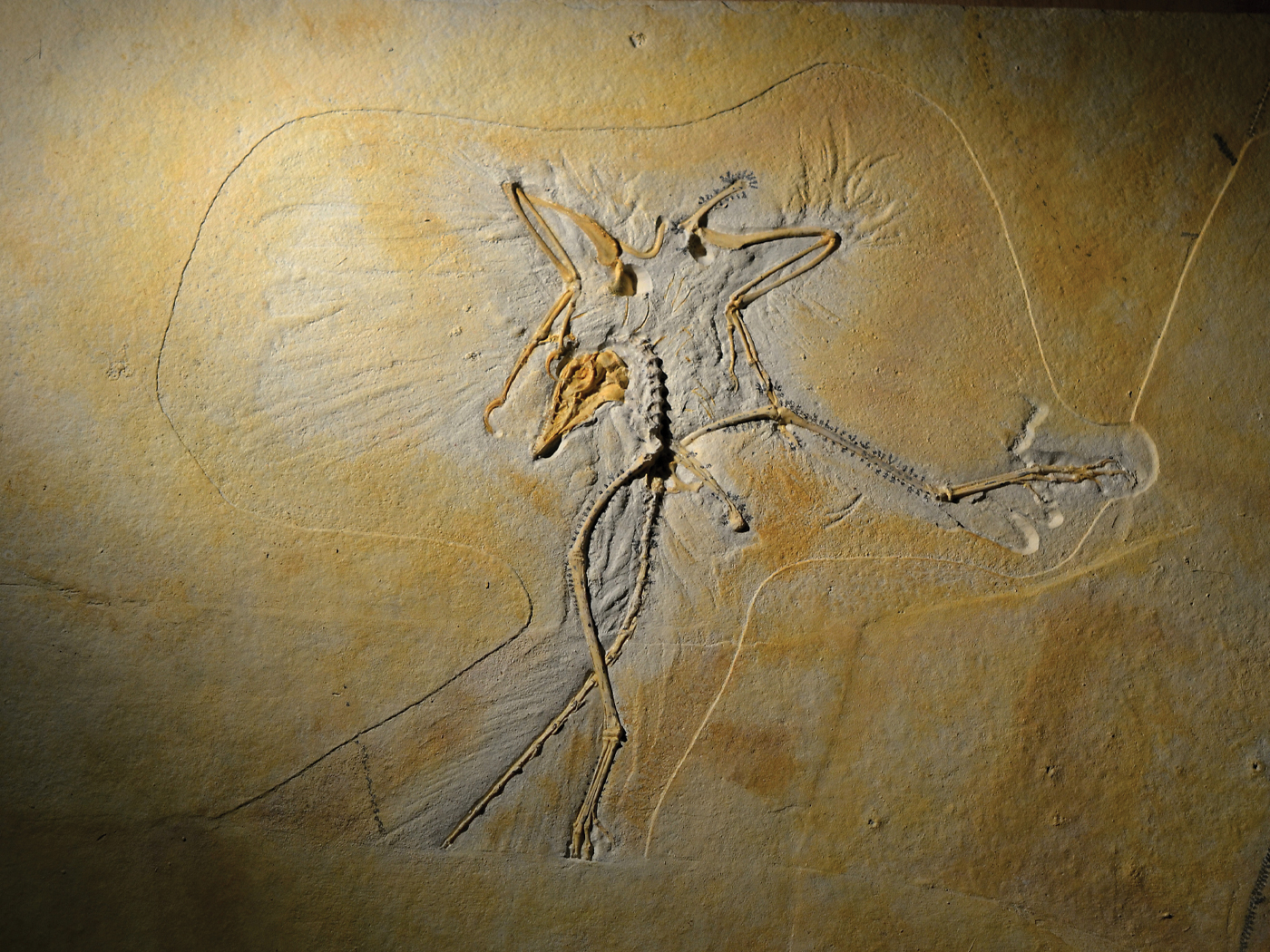The presence of measurable radiocarbon in fossil wood supposedly tens and hundreds of millions of years old has been well-documented.1-5 Baumgardner6 has similarly reported measurable radiocarbon in ancient organic materials, well above the threshold of the accelerator mass spectrometry (AMS) analytical technology used, including ten samples of US coals spanning 45-300 million years of the conventional timescale for the geologic record. Meticulous laboratory procedures rule out the possibility that this measured radiocarbon is due to contamination, so it must instead be intrinsic to these ancient organic materials. However, such is the rapid decay of radiocarbon (14C), with a half-life of 5,730 years, that even after only 250,000 years there should be no detectable radiocarbon left. Thus, organic materials supposedly millions of years old should not contain any radiocarbon whatsoever.
Cripple Creek, Colorado
Cripple Creek is the premier gold mining district of Colorado, having produced more than 23 million ounces of gold since 1891. The gold is found in veins and surrounding rocks associated with a small (six square mile) volcanic complex that is supposedly 32 million years old (Oligocene), as determined by Ar-Ar radioisotope dating.7 The complex was formed by explosive volcanism from multiple coalescing eruptive centers, episodic intrusion of alkaline igneous rocks (ranging from phonolite to lamprophyre), development of funnel-shaped breccia pipes, and repeated eruption and subsidence cycles.8 A two-phased mineralizing event closely followed emplacement of the volcanic complex. First, a high-temperature fluid flow phase caused alteration of the host volcanic rocks and increased their permeability. Then a subsequent low-temperature fluid flow phase deposited in steeply dipping veins and disseminated gold into the porous wall rocks.9
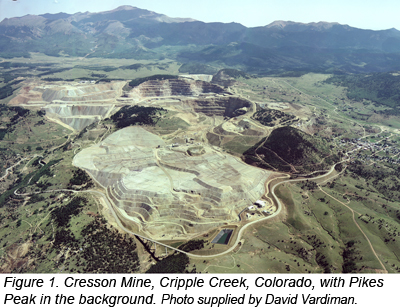
The Cresson Mine (Figure 1) exploits the most valuable deposit in the district, having produced more than 3 million ounces of gold. Its gold mineralization is associated with an ultramafic lamprophyre pipe, which at supposedly 27 million years old was one of the last volcanic events to occur in the district.10 The gold in the Cresson deposit is generally less than 20 microns in size and occurs in three principal forms: native gold as embayments or replacements along the margins of pyrite grains, or even intergrown with pyrite; as native gold associated with hydrous iron and manganese oxides after tellurides; and as gold-silver tellurides primarily in quartz-fluorite veins. Oxidation of the deposit is strongest and deepest along major structural zones, but generally has a nominal depth of 400 feet.
Ancient Fossil Wood
Historic reports are common of early miners encountering pieces of petrified and coalified wood in the deep workings of the mines.11-13 Many tree parts, ranging from small pieces of wood up to logs, trunks and a whole stump, have been found mixed in with the Cripple Creek Breccia that hosts the gold mineralization. Coalification of the fossil wood was common, and growth rings and other woody structures such as knots and bark had been retained. The original trees were undoubtedly conifers, probably belonging to a species of Pinus.
Carbonized fossil wood was also found in the Cresson Mine, including a log, at depths of 800 feet or more down from the surface.13 In July 1947, a small 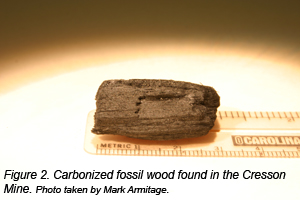 piece of coalified wood, measuring almost 3 centimeters in length (Figure 2), was found in a "sand bed" within rock, possibly sand-sized volcanic breccia (tuff and rock fragments) intruded by the lamprophyre pipe, on the 17th level of the underground workings, some 1,700 feet below the surface.14 Furthermore, a cored exploration hole drilled in 2003 intersected a small piece of carbonized fossil wood in tuff and rock fragments of the Cripple Creek Breccia at a vertical depth of 3,079 feet beneath the surface under the mine.15
piece of coalified wood, measuring almost 3 centimeters in length (Figure 2), was found in a "sand bed" within rock, possibly sand-sized volcanic breccia (tuff and rock fragments) intruded by the lamprophyre pipe, on the 17th level of the underground workings, some 1,700 feet below the surface.14 Furthermore, a cored exploration hole drilled in 2003 intersected a small piece of carbonized fossil wood in tuff and rock fragments of the Cripple Creek Breccia at a vertical depth of 3,079 feet beneath the surface under the mine.15
The postulated mechanism responsible for burying this fossil wood so deeply within this volcanic complex is the subsidence that followed many violent volcanic eruptions. When the magmas rose through cracks and conduits they encountered groundwater, resulting in phreatic explosions. Violent jets of volcanic ash and billowing clouds of steam shook the landscape, sweeping away trees and other vegetation, brecciating the surrounding rocks to great depths, and thoroughly mixing all of the shattered materials. As these eruptions finished, the resultant breccias subsided into the deep holes from which the magmas had been blasted into ash and steam, taking with them the wood debris and burying it.
Radiocarbon Analyses
Some very small splinter-like fragments, collectively weighing 128 milligrams, were gently broken off from one end of the piece of carbonized fossil wood that was found in July 1947 in the Cresson Mine. The specimen was kindly provided by geologist David M. Vardiman, who at the time was working for the Cripple Creek & Victor Gold Mining Company, the current operators of the mine. After being carefully packaged and labeled, this sample was submitted with the required documentation to Professor Roelf Beukens at the IsoTrace Radiocarbon Laboratory at the University of Toronto in Ontario, Canada.
At this laboratory, the sample was prepared for analysis with a modified AAAOx pretreatment,16 the standard procedure developed to guarantee the elimination of any contamination. First, though, the sample was demineralized to remove any contaminant inorganic minerals. This involved drenching the samples in hot and strong hydrochloric acid to dissolve away any calcium, barium, or strontium salts (which is done to avoid producing insoluble fluorides in the next step), and then soaking the sample for at least a week in a hot and strong mixture of hydrochloric and hydrofluoric acids. After this, the acid-soluble humics were removed from what remained of the sample with an extended hot and strong hydrochloric acid. This was followed by an extended cold and fresh alkali extraction. The laboratory reported that the dried residue consisted of needles with a carbon content normal for organic material. A very short chlorite bleach treatment then had to be used because the sample rapidly oxidized. Before subsequent combustion, the sample was degasified under vacuum.
The resultant graphite was then analysed for radiocarbon using the laboratory's state-of-the-art AMS system. Four separate highprecision analyses were averaged and corrected for natural and sputtering isotope fractionation using the measured 13C/12C ratios. The averaged radiocarbon analysis reported by the laboratory, after the laboratory "background correction" of 0.077 percent modern carbon was subtracted, was 0.588 ± 0.069 percent modern carbon. This equates to an apparent uncalibrated radiocarbon age of 41,260 ± 540 years before present (BP), using the Libby meanlife of 8,033 years. The quoted errors represent the 68.3% confidence limits.
Discussion
The volcanic rock materials in which this piece of carbonized fossil wood was found are claimed to be 32 million years old, yet the wood yielded a radiocarbon age of only 41,260 years, well within the measurement limits of this dating method. The usual response to such a glaring and enigmatic discrepancy is to claim that the wood had obviously been contaminated with modern carbon, making it date young when in fact it really is extremely old.
Four sources of potential contamination could be invoked in this instance. First, any contamination in the laboratory can be immediately ruled out, because extreme handling and preparation measures were used in this highly respected academic laboratory, measures that have proved effective in removing any potential contamination. This included extended use of strong acids to guarantee removal of any carbonate and other minerals that might have contributed modern radiocarbon to the wood. Second, any contamination due to handling of the sample--for example, from human hands or plastic storage bags--can also be definitively ruled out, because any such contamination would only have been on the sample's surface and would have been immediately eliminated by the laboratory's extreme sample preparation techniques.
The third potential source of contamination would have been the source area in the ground from which the sample was taken. Here there were definitely many relevant factors. At the time of burial of this wood in this volcanic complex, there were the hot temperatures of the volcanic ash and of the waters in the surface sediments in which the original trees grew and in any sedimentary strata beneath. Once the wood was buried, there would have been circulation of these waters as hydrothermal fluids through the volcanic pile when the gold mineralization was deposited. The resultant hydrothermal alteration is pronounced and complex, but includes carbonate and silicate minerals, and silica (quartz).17 However, no carbonate minerals or silica were in any way visibly evident within or clinging to the wood when the sample was collected, stored, and then sent to the laboratory. In any case, such minerals would have been removed from the wood, even from within it, by the severe demineralizing treatment in the laboratory. Furthermore, the hydrothermal fluids at the time of introducing dissolved minerals to the volcanic pile and altering it, supposedly 32 million years ago, would have only contained old carbon, which if anything would have swamped any radiocarbon in the wood so that it should have yielded an infinite radiocarbon age, consistent with it being supposedly that old.
This only leaves, finally, the fourth potential source of contamination--namely, the groundwater percolating through the volcanic rocks and the carbonized fossil wood right up until the present. This can be likewise ruled out, because at 1,700 feet below the present land surface, any groundwater within the rocks and wood would have virtually no connection with any modern radiocarbon in the atmosphere, soils, and weathered rocks well above them. Furthermore, as a consequence of the many interconnected mining tunnels, and then the drilling in 1941 of a drainage tunnel some 3,100 feet below the surface under the mines, the whole area has been gradually de-watered by gravity so that water saturation in the rocks is now rarely encountered above 2,460 feet below the surface. In any case, any soluble inorganic carbonate carbon in the groundwater would not have exchanged with the insoluble organic carbon in the wood, because the two forms of carbon are incompatible. Also, any carbonate mineral deposited within or onto the wood by the groundwater would have also been removed by the severe demineralizing treatment in the laboratory.
It can only be concluded, therefore, that the radiocarbon measured by the laboratory must be real in situ radiocarbon intrinsic to the original wood, and not contamination of any sort. This does not imply that this radiocarbon is a reliable measure of the wood's true age. In fact, other fossil woods analyzed for radiocarbon have yielded various other "ages." However, it does indicate that the wood is young, and not 32 million years old. Clearly, the long-age radioactive Ar-Ar dating method used to determine that age for the volcanic rocks hosting the carbonized wood is totally unreliable, due to the unproven assumptions on which it is based and the well-documented problems associated with it.18 On the other hand, radiocarbon testing of ten coal beds spanning a significant portion of the fossil-bearing strata record of the Genesis Flood yielded "ages" of 48,000–50,000 years;19 so at 41,260 years this carbonized wood could arguably be dated as late Flood or even post- Flood, and thus only about 4,300 years old.
It should also be noted that this radiocarbon "date" was calculated on the assumption that this carbonized wood had similar radiocarbon content when it was buried to the radiocarbon content of modern trees. However, this assumption can be shown to be false for at least two reasons. First, the Flood removed so much carbon from the biosphere and buried it. Second, the earth's magnetic field was much stronger in the recent past back to the Flood, resulting in a much lower radiocarbon production rate in the atmosphere. These two factors thus would have meant that there was much less radiocarbon in ancient buried organic materials. Therefore, the required recalibration of the radiocarbon "dates" for these supposedly ancient organic materials would significantly reduce their true ages to make them compatible with the biblical timescale of earth history.
Conclusions
Carbonized fossil wood was found in July 1947 in volcanic "sand" within the Cripple Creek Breccia at 1,700 feet underground in the Cresson Mine, Cripple Creek, Colorado. Fragments from a sample of this wood were submitted for radiocarbon analysis to the IsoTrace Radiocarbon Laboratory at the University of Toronto, Canada. The high-precision AMS analyses of the wood revealed an average radiocarbon content of 0.588 ± 0.069 percent modern carbon (after subtraction of the laboratory's "background correction" of 0.077 percent modern carbon), which equates to an apparent uncalibrated radiocarbon age of 41,260 ± 540 years BP. Because any and all sources of potential contamination were removed by the laboratory's severe chemical pre-treatment and can thus be discounted, this radiocarbon was concluded to be real, in situ, and intrinsic to the original wood. This age conflicts starkly with the Ar-Ar radioisotope date of 32 million years for the volcanic rock in which the wood was buried, rendering that method totally unreliable. On the other hand, comparison with radiocarbon dates for coal beds deposited during the Flood year suggests that this carbonized fossil wood is likely only about 4,300 years old, buried by the late Flood or even post-Flood volcanic activity that also generated the Cripple Creek gold deposits.
References
- Snelling, A.A. 1997. Radioactive “dating” in conflict! Fossil wood in ancient lava yields radiocarbon. Creation Ex Nihilo. 20(1): 24-27.
- Snelling, A.A. 1998. Stumping old-age dogma: radiocarbon in an “ancient” fossil tree stump casts doubt on traditional rock/fossil dating. Creation Ex Nihilo. 20(4): 48-51.
- Snelling, A.A. 1999. Dating dilemma: fossil wood in ancient sandstone. Creation Ex Nihilo. 21(3): 39-41.
- Snelling, A.A. 2000. Geological conflict: young radiocarbon date for ancient fossil wood challenges fossil dating. Creation Ex Nihilo. 22(2): 44-47.
- Snelling, A.A. 2000. Conflicting “ages” of Tertiary basalt and contained fossilized wood, Crinum, central Queensland, Australia. Creation Ex Nihilo Technical Journal. 14(2): 99-122.
- Baumgardner, J.R. 2005. 14C Evidence for a Recent Global Flood and a Young Earth. In Vardiman, L., A.A. Snelling and E.F. Chaffin (eds.), Radioisotopes and the Age of the Earth: Results of a Young-Earth Creationist Research Initiative. El Cajon, CA: Institute for Creation Research, and Chino Valley, AZ: Creation Research Society, 587-630.
- Kelley, K.D. 1996. Origin and Timing of Magmatism and Associated Gold-Telluride Mineralization of Cripple Creek, Colorado. Ph.D. dissertation. Colorado School of Mines, Golden, CO.
- Thompson, T.B. et al. 1985. Mineralized Veins and Breccias of the Cripple Creek District, Colorado. Economic Geology. 80: 1669-1688.
- Kelley, K.D. et al. 1998. Geochemical and Geochronological Constraints on the Genesis of the Au-Te Deposits at Cripple Creek, Colorado. Economic Geology. 93: 981-1012.
- Kelley, 1996, reference 7; Pontius, J.A., and J.A. Head. 1996. Cresson Mine: Case History of a Rapidly Evolving Mining Project. Mining Engineering. January: 26-30.
- Rickard, T.A. 1900. The Cripple Creek Volcano. Transactions of the American Institute of Mining Engineers. 30: 367-403.
- Lindgren, W., and F.L. Ransome. 1906. Geology and Gold Deposits of the Cripple Creek District, Colorado. US Geological Survey Professional Paper 54.
- Loughlin, G.F., and A.H. Koschmann. 1935. Geology and Ore of the Cripple Creek District, Colorado. Colorado Scientific Society Proceedings. 13(6): 217-435.
- Vardiman, D.M. Personal email communication, July 12, 2006.
- Veatch, S.W., and T.R. Brown. 2004. Carbonized Wood from the Oligocene: Trapped in Cripple Creek’s Volcanic Complex. Trilobite Tales. January: 9-12.
- Beukens, R.P. Radiocarbon Analysis Report. IsoTrace Radiocarbon Laboratory, University of Toronto, February 9, 2007.
- Jensen, E.P. 2003. Magmatic and Hydrothermal Evolution of the Cripple Creek Gold Deposit, Colorado, and Comparisons with Regional and Global Magmatic-Hydrothermal Systems Associated with Alkaline Magmatism. Ph.D. dissertation. University of Arizona, Tucson, AZ.
- Snelling, A.A. 2000. Geochemical Processes in the Mantle and Crust. In Vardiman, L., A.A. Snelling, and E.F. Chaffin (eds.), Radioisotopes and the Age of the Earth: A Young-Earth Creationist Research Initiative. El Cajon, CA: Institute for Creation Research, and St. Joseph, MO: Creation Research Society, 123-304; and Snelling, Isochron Discordances and the Role of Inheritance and Mixing of Radioisotopes in the Mantle and Crust, in Radioisotopes and the Age of the Earth: Results of a Young-Earth Creationist Research Initiative, 393-524.
- Baumgardner, J.R. et al. 2003. Measurable 14C in Fossilized Organic Materials: Confirming the Young Earth Creation-Flood Model. In Ivey Jr., R.L. (ed.), Proceedings of the Fifth International Conference on Creationism. Pittsburgh, PA: Creation Science Fellowship, 127-142.
* Dr. Snelling is the Director of Research at Answers in Genesis.
Cite this article: Snelling, A. 2008. Radiocarbon in "Ancient" Fossil Wood. Acts & Facts. 37 (1): 10.




